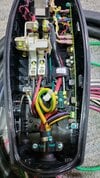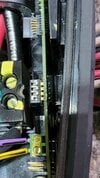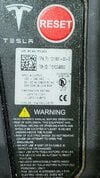Thing is, I have an actual original gen 1 Wall Connector that doesn't have the 90A circuit setting, so it really is an original, original. My 2021 Model Y, 2022 Model X and 2023 Model S (all LR) all work with it. Maybe only those cars that have a 32A charger in them don't work with it?
Wow, well this thread has gotten interesting. You're another longtimer here. How did we never hear of this before? I had temporarily forgotten there were two versions of the Gen1, and from the many threads on this around 2018 through 2021-ish, the best we knew was that none of the Gen1 could every work with ANY of the new cars. This is the very first time I'm hearing of it working ever. So that's wild. Maybe it's a difference of only one of the Gen1 types working, and the other is incompatible?
Whelp, I failed to fish electrical to my breaker panel over the weekend, and figured no big deal since I have 2 EVSEs I can use on either 120v, or my 240v dryer outlet.
Both EVSEs are GEN I Leaf that I modified to work on 120v or 240v. They charge a Toyota Prius and Nissan Leaf just fine. The Model Y hates it for some reason, on 120v or 240v. Sounds like whatever issue you're referring to.
Don't know why it wouldn't work with older EVSEs considering J1772 defines the specifications and protocols.
Heh, well, no it's not the issue I was referring to, because I'm talking about specifically Tesla's wall connector, not just old EVSE's in general. You have just brought up a totally different separate issue that was unique to the old charging cables that specifically came with the Nissan LEAF. They did not comply with the J1772 fully or properly, so some EVs would tolerate it, but the Teslas wouldn't. Here is a post about that:
We'll be visiting our daughter soon. She has a Leaf and a Nissan EVSE. I thought I could charge through that (with the J1772 adapter), but she said that that didn't work with another friend's Tesla. Anyone know why not? Thanks, Al

teslamotorsclub.com
"Yeah, those old Nissan EVSEs (made by Aerovironment) didn't have the negative half of the pilot signal. Most cars don't care, but some do, like Teslas. This used to cause owners problems."
No one has figured out what the specific compatibility issue is, or if there even is one.
Well, we do and we don't. Tesla made a switch to a different MCU or processor of some kind in the car at that time and acknowledged that the cars that were built with the new one would not work with the old wall connectors. It was something about communication or signal timing, but I don't think we have enough specific information in that area to say precisely exactly what this incompatibility is.
It could be as simple as these 10+ year old EVSEs are falling out of spec and some cars are more sensitive to the slightly out of spec EVSEs.
No, it's definitely not about 10 year old anything, because this showed up very suddenly in 2018/2019, when these things weren't very old, and it was very easy to observe with the old Gen1 wall connectors at hotels. All of the old cars continued to work fine without a hitch, and all of the newly built cars just could not work with them.
My theory on what has happened is that we have finally come back around on the computer systems that are in the cars. Tesla has changed the MCUs and redesigned things a few times, and maybe this issue hasn't been revisited and tested again in quite a while. We had a long period of several years of cars that would not work with the Gen1 wall connectors, but maybe something in the even newer generation of computers in the more recent years and models does have compatibility with them again.





